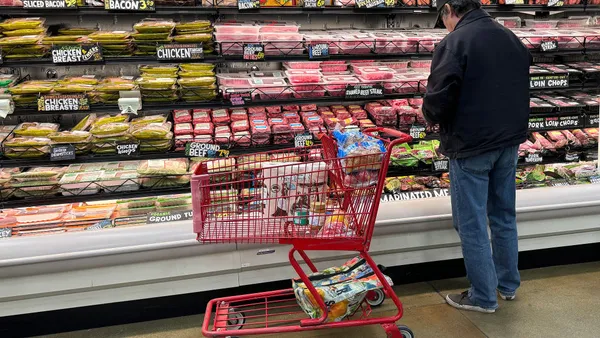Dive Brief:
- President Donald Trump signed an executive order May 7 to accelerate the approval pathway for off-shore aquaculture in federal waters. There will be a two-year deadline for permitting projects, and applications will be overseen by the National Oceanic and Atmospheric Administration.
- In addition to speeding up the approval process for commercial fishing, the Trump administration announced a $300 million allocation through the Coronavirus Aid, Relief and Economic Security (CARES) Act to support fishermen and related businesses hurt by the pandemic. Alaska and Washington will receive the largest allocations, with $50 million each, according to the Food & Environment Reporting Network.
- The executive order is an effort to strengthen the U.S. domestic fishing industry and has drawn support from commercial fisheries, but has also elicited criticism from environmental groups.
Dive Insight:
The coronavirus pandemic has decimated the seafood industry in the U.S. Following the widespread closure of restaurants and food service locations, many of the country's fisheries have reported sales dropping as much as 95%. Thousands of commercial fishers are at risk of bankruptcy, The Washington Post reported.
Shortly after sales started to plummet, seafood companies — including Trident, Pacific Seafoods, High Liner, Cargill and Fortune International — wrote a letter to the Trump administration to ask for financial support. Although the industry anticipated the need for billions of dollars, the government only approved an aid package for $300 million at first.
Now the government is offering additional support with another $300 million in financial aid, as well as an attempt to bolster domestic production. Currently, domestic aquaculture production is either done on land or in state-controlled waters and is only a small portion of U.S. seafood. Aquaculture accounted for 20% of the country's seafood production in 2016, according to NPR. The outlet reported that U.S. production is dwarfed by imports, which account for 90% of the country’s seafood consumption.
These figures rank the U.S. 17th in global aquaculture production. According to the federal government, this latest change to the approval pathway for commercial fishing farms in federal waters will "maximize commercial fishing" and "help solidify our Nation’s food security, protect American jobs in the seafood industry, and create new jobs in the United States."
Supporters of the order range from seafood conglomerates to senators. Roll Call reported Sen. Bill Cassidy of Louisiana welcomed the funding saying it is a "great start." Cassidy was part of a bipartisan group of 24 senators from coastal states that sent a letter to the Senate majority leader the day before the order was signed that requested $4 billion from federal agencies to support the fishing business.
Although there is support both for the funding and the deregulation of federal waters for aquaculture, there is also criticism of the move. A variety of fisheries advocates and environmentalists say the new order has the potential to endanger both ocean life and the independent fishing industry.
Trump's order grants the country’s eight regional fishery authorities six months to compose a list of recommended actions to reduce burdens on domestic fishing. These authorities set fishing seasons, quotas and other management plans. Advocates fear reducing this burden could lead to overfishing and reduction of wild fisheries, The Food & Environment Reporting Network reported.
The order also requires a draft for a nationwide permit for ocean aquaculture from the U.S. Army Corps of Engineers within 90 days. With the nation reeling from a pandemic and its consequences, there is a chance this plan will not receive the amount of public input that it might otherwise get. Even when a plan is finalized, these offshore aquaculture facilities may not be set up in time to provide jobs or seafood resources to those who are in need as a result of the pandemic.
The influx of financial aid, while more immediate, will likely not be enough either. On multiple occasions, stakeholders have requested several billion dollars in aid. To date, the government has provided just $600 million to the fishing industry.
However, with the seafood industry in such dire straits — about 68% of the $102.2 billion that consumers paid for U.S. fishery products in 2017 was spent in foodservice, which is now a closed market — some financial aid is better than none.











